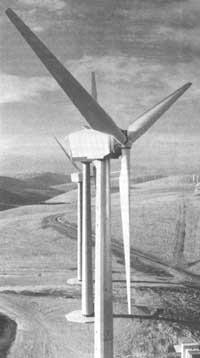What are the waves and how much energy do they have?
1999/10/01 Mujika, Alfontso - Elhuyar Fundazioa Iturria: Elhuyar aldizkaria
The waves originate on the surface of the sea by the action of the wind, that is, the wind blows with force and fixed direction and pushes the surface of the water; part of its kinetic energy passes to the water and concentrates on it, that is, it accumulates. Wind energy is due to solar energy, so wave energy, although indirectly, comes from the Sun.
Being sine waves, the main characteristics of waves are amplitude, wavelength and period. The amplitude is half the height and the height is the vertical distance between the highest part of the wave (top) and the lowest (depression). The wavelength is the horizontal distance between two consecutive peaks and the period is the time it takes two consecutive waves to pass through a fixed point.
The ratio between height and wavelength is used to classify waves. According to this, small waves (for example, with a wavelength 150 times greater than height) and small waves (for example, with a wavelength 15 times greater than height). But how much energy does the waves accumulate?
Because the direction and strength of the wind are very variable, the waves produced by it are also variable. In addition, the depth of water also influences the wave. The wave is a phenomenon that occurs on the surface of the water, but if the depth of the water is equal to or less than half the wavelength of the wave, the background hinders the movement of the lower part of the wave and therefore decreases the speed and height of the wave. Therefore, the calculation of energy carried by waves is very complex. Wave energy is proportional to wavelength and height square. Numerous tests have been carried out to measure this energy, estimating in general an average power of 45 kilowatts per meter wide.
But, as we have said, waves are not the same everywhere. On the map above it can be observed that the "wave rich" coasts are those in which the western coast looks to the ocean, especially at a latitude between 40º and 60º: Chile, South Australia, South West New Zealand and West Europe, especially Ireland, Scotland and Iceland, as well as West Canada and the South African Republic.
However, the strong waves do not necessarily imply the ease of use of wave energy, as there are other factors. For example, some of these places are very isolated and the means of transport to reach them are not suitable. Perhaps the most appropriate places are in the central islands of the Pacific, where the energy of the waves is not very high, since the energy and direction of the waves are quite fixed. In addition, in these islands there are no fossil fuels and in order to produce electricity they need to import oil.

Gai honi buruzko eduki gehiago
Elhuyarrek garatutako teknologia






